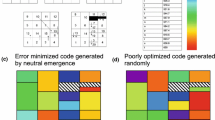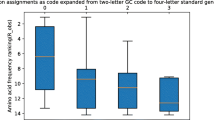Abstract
The genetic code has the remarkable property of error minimization, whereby the arrangement of amino acids to codons is highly efficient at reducing the deleterious effects of random point mutations and transcriptional and translational errors. Whether this property has been explicitly selected for is unclear. Here, three scenarios of genetic code evolution are examined, and their effects on error minimization assessed. First, a simple model of random stepwise addition of physicochemically similar amino acids to the code is demonstrated to result in substantial error minimization. Second, a model of random addition of physicochemically similar amino acids in a codon expansion scheme derived from the Ambiguity Reduction Model results in improved error minimization over the first model. Finally, a recently introduced 213 Model of genetic code evolution is examined by the random addition of physicochemically similar amino acids to a primordial core of four amino acids. Under certain conditions, 22% of the resulting codes produced according to the latter model possess equivalent or superior error minimization to the standard genetic code. These analyses demonstrate that a substantial proportion of error minimization is likely to have arisen neutrally, simply as a consequence of code expansion, facilitated by duplication of the genes encoding adaptor molecules and charging enzymes. This implies that selection is at best only partly responsible for the property of error minimization. These results caution against assuming that selection is responsible for every beneficial trait observed in living organisms.


Similar content being viewed by others
References
Alff-Steinberger C (1969) The genetic code and error transmission. Proc Natl Acad Sci USA 64:584–591
Aravind L, Anantharaman V, Koonin EV (2002) Monophyly of class I aminoacyl tRNA synthetase, USPA, ETFP, photolyase and PP-ATPase nucleotide binding domains: implications for protein evolution in the RNA world. Proteins 48:1–14
Ardell DH (1998) On error minimization in a sequential origin of the standard genetic code. J Mol Evol 47:1–13
Crick FH (1968) The origin of the genetic code. J Mol Biol 38:367–379
Di Giulio M (1989) The extension reached by the minimization of the polarity distances during the evoluton of the genetic code. J Mol Evol 29:288–293
Di Giulio M (2001) The origin of the genetic code cannot be studied using measurements based on the PAM matrix because this matrix reflects the code itself, making any such analyses tautologous. J Theor Biol 208:141–144
Di Giulio M, Medugno M (1999) Physicochemical optimization in the genetic code origin as the number of codified amino acids increases. J Mol Evol 49:1–10
Eggertsson G, Soll D (1988) Transfer ribonucleic acid-mediated suppression of termination codons in Escherichia coli. Microbiol Rev 52:354–374
Feng L, Sheppard K, Namgoong S, Ambrogelly A, Polycarpo C, Randau L, Tumbula-Hansen D, Soll D (2004) Aminoacyl-tRNA synthesis by pre-translational amino acid modification. RNA Biol 1:16–20
Fitch WM, Upper K (1987) The phylogeny of tRNA sequences provides evidence for ambiguity reduction in the origin of the genetic code. Cold Spring Harbor Symp Quant Biol 52:759–767
Freeland SJ, Hurst LD (1998) The genetic code is one in a million. J Mol Evol 47:238–248
Freeland SJ, Knight RD, Landweber LF, Hurst LD (2000) Early fixation of an optimal genetic code. Mol Biol Evol 17:511–518
Gilis D, Massar S, Cerf NJ, Rooman M (2001) Optimality of the genetic code with respect to protein stability and amino-acid frequencies. Genome Biol 2:11
Goldman N (1993) Further results on error minimization in the genetic code. J Mol Evol 37:662–664
Goodarzi H, Nejad HA, Torabi N (2004) On the optimality of the genetic code, with consideration of termination codons. BioSystems 77:163–173
Gould SJ, Lewontin RC (1979) The spandrels of San Marco and the Panglossian paradigm: a critique of the adaptationist programme. Proc R Soc Lond B Biol Sci 205:581–598
Grantham R (1974) Amino acid difference formula to help explain protein evolution. Science 185:862–864
Haig D, Hurst LD (1992) A quantitative measure of error minimization in the genetic code. J Mol Evol 33:412–417
Ikehara K, Niihara Y (2007) Origin and evolutionary process of the genetic code. Curr Med Chem 14:3221–3231
Jakubowski H, Goldman E (1992) Editing of errors in selection of amino acids for protein synthesis. Microbiol Rev 56:412–429
Kvenvolden KA, Lawless J, Pering K, Peterson E, Flores J, Ponnamperuma C, Kaplan IR, Moore C (1970) Evidence for extraterrestrial amino acids and hydrocarbons in the Murchison meteorite. Nature 228:923–926
Lawless JG, Kvenvolden KA, Peterson E, Ponnamperuma C, Moore C (1971) Amino acids indigenous to the Murray meteorite. Science 173:626–627
Massey SE (2006) A sequential ‘2-1-3’ model of genetic code evolution that explains codon constraints. J Mol Evol 62:809–810
Miller SL (1953) A production of amino acids under possible primitive earth conditions. Science 117:528–529
Nagel GM, Doolittle RF (1995) Phylogenetic analysis of the aminoacyl-tRNA synthetases. J Mol Evol 40:487–498
Ohno S (1970) Evolution by gene duplication. Springer-Verlag, New York
Sella G, Ardell DH (2002) The impact of message mutation on the fitness of a genetic code. J Mol Evol 54:638–651
Sonneborn TM (1965) Evolving genes and proteins. Academic Press, New York
Woese CR (1965) On the evolution of the genetic code. Proc Natl Acad Sci USA 54:1546–1552
Wong JT (1975) A co-evolution theory of the genetic code. Proc Natl Acad Sci USA 72:1909–1912
Xue H, Tong KL, Marck C, Grosjean H, Wong JT (2003) Transfer RNA paralogs: evidence for genetic code-amino acid biosynthesis coevolution and an archaeal root of life. Gene 310:59–66
Acknowledgments
The author would like to thank three anonymous referees of an early version of the manuscript, and two subsequent reviewers, for their valuable and constructive comments. I would also like to thank Dr. B. R. Francis (University of Wyoming) for his critique.
Author information
Authors and Affiliations
Corresponding author
Rights and permissions
About this article
Cite this article
Massey, S.E. A Neutral Origin for Error Minimization in the Genetic Code. J Mol Evol 67, 510–516 (2008). https://doi.org/10.1007/s00239-008-9167-4
Received:
Revised:
Accepted:
Published:
Issue Date:
DOI: https://doi.org/10.1007/s00239-008-9167-4




